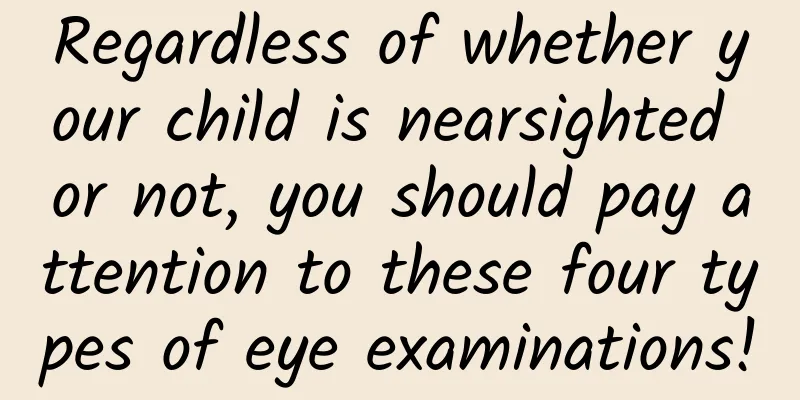Regardless of whether your child is nearsighted or not, you should pay attention to these four types of eye examinations!

|
Not long ago, the latest monitoring data from the National Center for Disease Control and Prevention showed that the overall myopia rate among children and adolescents in my country was 51.9% in 2022. Among students who already have myopia, mild, moderate, and severe myopia accounted for 53.3%, 37.0%, and 9.7%, respectively, and the proportion of severe myopia has decreased. Compared with previous years, the overall myopia rate among children and adolescents in my country has shown a downward trend, and the trend of myopia at a younger age has been alleviated, but the situation of myopia prevention and control remains severe. * As the "gatekeeper" of children's myopia prevention and control, parents need to pay attention to the four stages of their children's myopia development. 1. Take precautions against myopia if you haven’t already! Hyperopia reserve is a protective factor for the eyes, which is equivalent to a buffer zone, preventing children from becoming myopic so quickly. If you still have the habit of overusing your eyes when your hyperopia reserve is depleted quickly, you may develop myopia. In general, hyperopia reserve is constantly decreasing, but it is usually not a straight line decline, and the speed of decline is different for each child. 2. Identify suspected myopia! True myopia generally refers to axial myopia. Due to congenital or acquired factors, the eye axis becomes longer and exceeds the normal value. When parallel light from a distance enters the eyeball, its focus falls in front of the retina, making it impossible to form a clear image. Pseudomyopia is temporary blurred vision caused by long-term overuse of the eyes, which leads to visual fatigue and excessive tension of the ciliary muscles . The main method to judge true and false myopia is ciliary muscle paralysis optometry (mydriasis optometry) . The essence of mydriasis optometry is to relax the fatigue caused by long-term excessive tension of the eye muscles. If there is no degree after mydriasis optometry, it is pseudomyopia and it is recommended to observe; if there is myopia, it is true myopia and it is recommended to wear glasses. 3. If you already have myopia, control it! High-risk groups for high myopia mainly include those with abnormal eye development, family history of high myopia, and long-term bad eye habits. High myopia has a strong hereditary tendency. When a child's parents suffer from high myopia, their children are also very likely to suffer from high myopia. If you read with your head tilted, lying down, walking, or use your eyes in too bright or too dark light, you may also develop high myopia. 4. Remedies for severe myopia! When the axial length of the eye of a patient with high myopia continues to lengthen, some changes may occur in the fundus. If foveal hemorrhage or subretinal neovascularization occurs, vision will be affected. Vitreous liquefaction, posterior vitreous detachment, retinal lattice changes, macular holes, etc. may also occur, leading to retinal detachment. In addition, the risk of cataracts and glaucoma in patients with high myopia will also increase significantly. |
<<: Effect of emotional problems on motor function recovery after stroke
>>: How to regulate the three highs? Why not try slow living?
Recommend
How to fillet fish without bones when boiling it? Should I use high or low heat when boiling fish?
When boiling fish, the amount of water should not...
Uterine vaccine age
The uterine vaccine, also known as the cervical c...
What are the examination items during the second trimester?
Prenatal check-up is an essential part of pregnan...
Counterpoint: Refurbished smartphone market to grow 15% in 2021, outstripping new smartphone market's 4.5% growth
In 2021, the refurbished smartphone market grew 1...
How to relieve the pain of period
Stomach pain, bloating, cold hands and feet durin...
Can I eat fruit after a miscarriage?
You can eat fruits after a miscarriage. Not all f...
What causes back pain in women?
If a woman suffers from back pain, she should be ...
Shocked! Eating, drinking and having fun can actually cause this disease?
Recently, the Eyelid and Orbital Disease/Ocular P...
Bed rest HCG doubles faster
If hcg dosing is not good during pregnancy, it ma...
[Medical Q&A] Can artificial disc replacement be performed for cervical spondylosis?
Planner: Chinese Medical Association Reviewer: Sh...
Can pregnant women eat spicy crayfish?
It is not clear since when spicy lobster has beco...
What is curry powder? What dishes are suitable for curry powder?
Curry powder is a condiment originating from Indi...
How to solve chest pain and lumps
Female friends may be more familiar with the situ...
Can a woman still have children after having a vasectomy?
In modern life, people have taken many measures t...
Can Xiaoqinggan be drunk every day? Why can't Xiaoqinggan be soaked all the time?
You can drink a little Xiaoqinggan every day, but...









